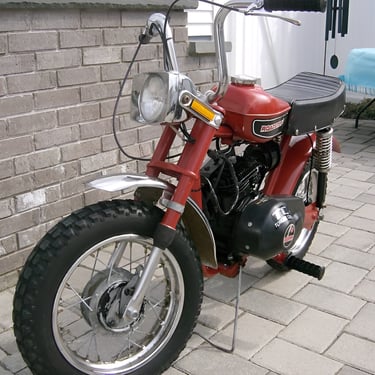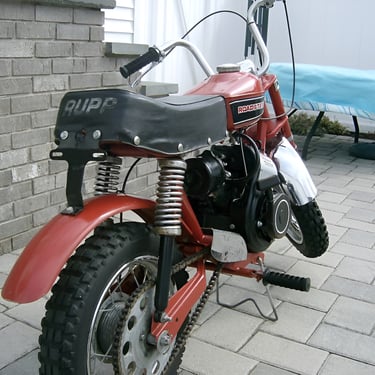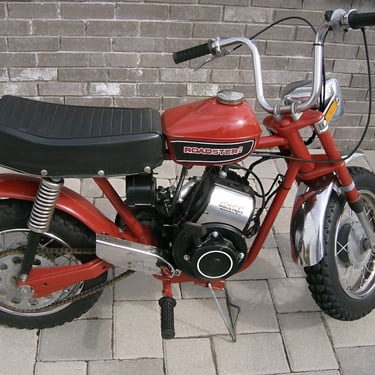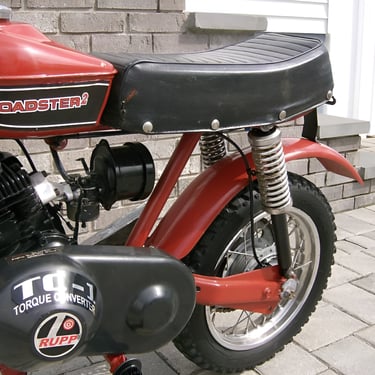1971 RUPP Roadster Minibike: A Comprehensive Guide
The article provides a comprehensive guide to the 1971 RUPP Roadster minibike, a classic vintage model known for its distinctive design and impressive performance.
1970'SMINI-BIKESFOUR STROKEUNITED STATES
6/30/20243 min read
My post content






1971 RUPP Roadster Minibike: A Comprehensive Guide
Introduction
The 1971 RUPP Roadster minibike is a classic example of vintage minibike engineering that has captured the attention of enthusiasts and collectors alike. Produced by RUPP Industries, a company known for its high-performance vehicles, the 1971 Roadster represents a significant milestone in the history of minibikes. With its distinctive design and robust build, the Roadster was a popular choice among young riders and remains a sought-after collectible today.
Historical Background
RUPP Industries was founded in 1959 by Mickey Rupp in Mansfield, Ohio. Initially a small operation with just eight employees, the company quickly expanded its footprint in the world of recreational vehicles, including go-karts and minibikes. By the early 1970s, RUPP had become a well-known name in the industry, celebrated for its innovative designs and high-performance machines.
The release of the 1971 RUPP Roadster marked a significant development for the company. This model was part of RUPP's broader strategy to offer a versatile and stylish minibike that could cater to both young riders and adult enthusiasts. The 1971 Roadster included a series of enhancements over its predecessors, making it a standout product in the RUPP lineup of that era.
Design and Specifications
One of the core attractions of the 1971 RUPP Roadster is its intricate design and impressive specifications. The minibike was equipped with a robust Tecumseh HS40 engine, which delivered approximately 4 horsepower. This engine was paired with a TC-1 torque converter, which provided smooth acceleration and enhanced the bike's overall performance.
The design of the 1971 Roadster featured a sturdy steel frame, designed for durability and stability. The bike's suspension system included front telescopic forks and a rear swingarm with two shock absorbers, ensuring a comfortable ride even on uneven terrain. The Roadster was also fitted with drum brakes on both the front and rear wheels, offering reliable stopping power.
In addition to its mechanical robustness, the Roadster showcased distinctive aesthetic elements. The minibike was typically finished in bright colors, often with a metallic sheen that added to its visual appeal. The full suspension, fenders, and padded seat were all designed with both functionality and style in mind, making the Roadster not only a practical machine but also a fashionable one.
Performance and Ride Experience
The 1971 RUPP Roadster was well-regarded for its impressive performance capabilities. The combination of the Tecumseh HS40 engine and the TC-1 torque converter provided a seamless blend of power and control, making the minibike suitable for a variety of riders, from beginners to more experienced enthusiasts. Its acceleration was smooth and consistent, thanks to the torque converter, which helped manage the engine's power output effectively.
Riders of the 1971 RUPP Roadster often praise its balanced handling and responsive control. The bike's suspension system, with its front telescopic forks and dual rear shocks, absorbed bumps and irregularities in the terrain, ensuring a comfortable and steady ride. The drum brakes on both the front and rear wheels offered reliable stopping power, adding to the overall safety of the minibike.
User reviews from the era often highlight the Roadster's ease of use and enjoyable ride quality. Many riders appreciated the minibike's ability to handle both on-road and off-road conditions effectively. Whether navigating through neighborhood streets or exploring trails, the 1971 RUPP Roadster provided a versatile and enjoyable riding experience.
Collecting and Restoring the 1971 RUPP Roadster
Collecting vintage minibikes like the 1971 RUPP Roadster has become a popular hobby among enthusiasts. These minibikes, with their rich history and distinctive design, are often seen as valuable collectibles. Restoring a 1971 Roadster involves a detailed and meticulous process, ensuring that the minibike retains its original charm and functional quality.
Restorers usually start by sourcing original parts, which can sometimes be a challenging task due to the bike's age. The Tecumseh HS40 engine, TC-1 torque converter, and other mechanical components need careful attention. Cosmetic elements, such as the frame's paint job, fenders, and seat upholstery, are also restored to mirror the bike's original appearance.
Given its status as a collectible, a fully restored 1971 RUPP Roadster can fetch a handsome price at auctions and sales. Collectors are often willing to pay a premium for bikes that are in excellent condition, with original or accurately restored parts. This makes the restoration process not only a passion project for enthusiasts but also a potentially lucrative investment.
Forums and vintage minibike clubs provide valuable resources for collectors and restorers. These communities share tips on sourcing parts, techniques for restoration, and historical information about these classic minibikes. Engaging with fellow enthusiasts at shows and online forums can enhance the restoration experience, providing both knowledge and camaraderie.
